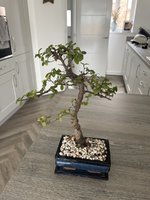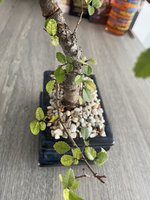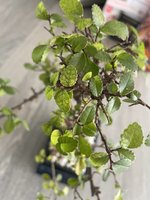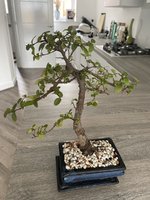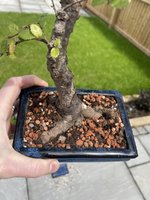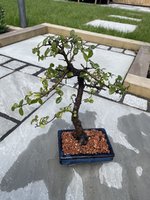The rocks on top were more for decoration to be honest. The mix I used was a bonsai substrate so pumice, lava rock etc. I actually repotted it fully in the substrate with no organic mix but started to worry as I only have house plants other than this one bonsai and have only ever used normal soil. It seemed so un natural potting something in rocks so I added some organic soil to the bonsai substrate.
Repotted in early May so just a couple of weeks ago, made sure there were no air pockets etc. It has been kept indoor all its life until I moved it outdoors a couple of weeks ago.
it has never been fertilised so might start there!
Would you recommend a larger pot in purely inorganic bonsai mix and fertilising it? Can I repot it again now to help it recover or will I need to wait? I might also move it back indoors if it’s adapted to live inside as we miss it in our office
Bonsai are NOT houseplants. Common mistake among beginners. FWIW, "houseplants" are tropical species (for the most part) that TOLERATE living inside. They don't adapt to indoors, they only endure the treatment.
Indoor conditions are extreme for any plant-- extremely low light (Even near a window, sunlight is about a fifth of direct outdoor sunlight), extremely low humidity (in the winter with heat on, it can be lower than a desert), no air circulation (wind is not an indoor phenomenon

. Air circulation is important to keep a lot of issues at bay, like fungus, certain insects, etc.)
Potting soil for indoor houseplants is made to hold onto water as watering can be iffy (no rain) and that pesky low humidity. Using such a moisture retentive soil with bonsai is possible, but it complicates things dramatically and requires expert watering skills. Good bonsai soil DRAINS very very well, but has components that hold onto some water and release it over time. Bonsai soil often terrifies those unfamiliar with it because it looks like "rocks."

Your tree has not been kept inside all its life. It probably grew from a seedling in a greenhouse before you got it (which technically is indoors, but unless you have glass ceilings and humidifiers in your house, etc. it's really not the indoors you might envision). It may have also been grown out at an actual outdoor nursery and then potted up in a bonsai pot. Rest assured it did not grow on a shelf in a living room as a seedling

You don't list where you live, but if it's late spring, the tree should be outside (a location with direct morning sun for about four hours, then afternoon shade is optimal).I would not repot it at this point and elms appreciate a little organic in their soil.
FWIW, watering bonsai is one of the most difficult things to learn. It takes time. (BTW, the actual rocks on the soil surface will complicate your watering hiding the soil surface and making it more difficult to see when it's time to water. I'd get rid of them) Most beginners overwater. Soil should dry a bit--the top inch or half inch should be dry before watering. This can vary tremendously. A dry windy day in June will dry the tree out quickly. It may require two waterings that day. A hot humid still day and the tree may not require it at all. That means you can't water on a schedule you plan out. You have to work with the tree's needs.
Also, moving back inside because it's missed will eventually mean you miss it because it died. It will die inside. It was already on its way and hopefully it will recover outside. It should remain outdoors for the rest of its life. You will have to provide winter protection. That protection can vary depending on your location. I'm in USDA zone 7 in Va. I've kept Chinese elm in a garden bed heavily mulched over winters that have seen temps as low as 0 F--but with regular winter temps ranging between 20-freezing 32. They're winter hardy and can take moderate winters pretty well. If you're in an area (please fill in your location in your avatar) that sees winter extremes --like Minnesota, etc.--it will require more substantial protection.
If you really want an "indoor" bonsai, get one made from a tropical species-ficus or a schefflera are two pretty tough species that can tolerate indoors for extended periods.

